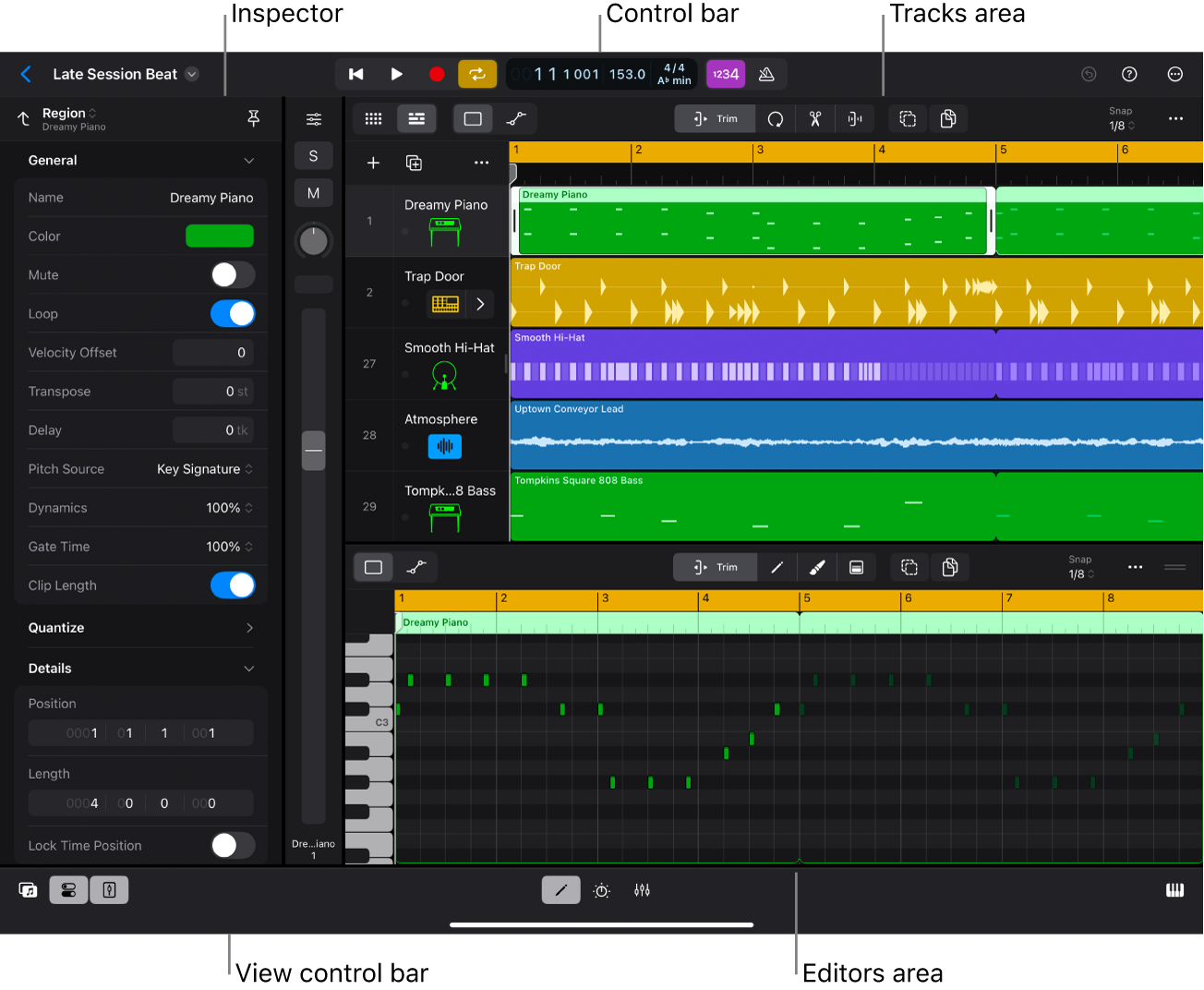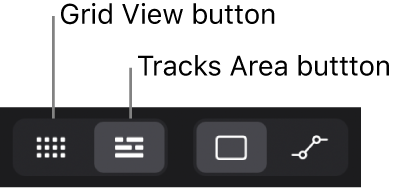Logic Pro User Guide for iPad
-
- What is Logic Pro?
- Working areas
- Work with function buttons
- Work with numeric values
- Undo and redo edits in Logic Pro for iPad
-
- Intro to tracks
- Create tracks
- Create tracks using drag and drop
- Choose the default region type for a software instrument track
- Select tracks
- Duplicate tracks
- Reorder tracks
- Rename tracks
- Change track icons
- Change track colors
- Use the tuner on an audio track
- Show the output track in the Tracks area
- Delete tracks
- Edit track parameters
- Start a Logic Pro subscription
- How to get help
-
- Intro to recording
-
- Before recording software instruments
- Record software instruments
- Record additional software instrument takes
- Record to multiple software instrument tracks
- Record multiple MIDI devices to multiple tracks
- Record software instruments and audio simultaneously
- Merge software instrument recordings
- Spot erase software instrument recordings
- Replace software instrument recordings
- Route MIDI internally to software instrument tracks
- Record with Low Latency Monitoring mode
- Use the metronome
- Use the count-in
-
- Intro to arranging
-
- Intro to regions
- Select regions
- Cut, copy, and paste regions
- Move regions
- Remove gaps between regions
- Delay region playback
- Trim regions
- Loop regions
- Repeat regions
- Mute regions
- Split and join regions
- Stretch regions
- Separate a MIDI region by note pitch
- Bounce regions in place
- Change the gain of audio regions
- Normalize audio regions in the Tracks area in Logic Pro for iPad
- Create regions in the Tracks area
- Convert a MIDI region to a Session Player region or a pattern region
- Replace a MIDI region with a Session Player region in Logic Pro for iPad
- Rename regions
- Change the color of regions
- Delete regions
-
- Intro to chords
- Add and delete chords
- Select chords
- Cut, copy, and paste chords
- Move and resize chords
- Loop chords on the Chord track
- Color chords on the Chord track
- Edit chords
- Work with chord groups
- Use chord progressions
- Change the chord rhythm
- Choose which chords a Session Player region follows
- Analyze the key signature of a range of chords
- Create fades on audio regions
- Extract vocal and instrumental stems with Stem Splitter
- Access mixing functions using the Fader
-
- Intro to Step Sequencer
- Use Step Sequencer with Drum Machine Designer
- Record Step Sequencer patterns live
- Step record Step Sequencer patterns
- Load and save patterns
- Modify pattern playback
- Edit steps
- Edit rows
- Edit Step Sequencer pattern, row, and step settings in the inspector
- Customize Step Sequencer
-
- Intro to mixing
-
- Channel strip types
- Channel strip controls
- Peak level display and clipping
- Set channel strip volume
- Set channel strip input format
- Set the output for a channel strip
- Set channel strip pan position
- Mute and solo channel strips
- Reorder channel strips in the Mixer in Logic Pro for iPad
- Replace a patch on a channel strip using drag and drop
- Work with plug-ins in the Mixer
- Search for plug-ins in the Mixer in Logic Pro for iPad
-
- Effect plug-ins overview
-
- Instrument plug-ins overview
-
- ES2 overview
- Interface overview
-
- Modulation overview
- Use the Mod Pad
-
- Vector Envelope overview
- Use Vector Envelope points
- Use Vector Envelope solo and sustain points
- Set Vector Envelope segment times
- Vector Envelope XY pad controls
- Vector Envelope Actions menu
- Vector Envelope loop controls
- Vector Envelope point transition shapes
- Vector Envelope release phase behavior
- Use Vector Envelope time scaling
- Modulation source reference
- Via modulation source reference
-
- Sample Alchemy overview
- Interface overview
- Add source material
- Save a preset
- Edit mode
- Play modes
- Source overview
- Synthesis modes
- Granular controls
- Additive effects
- Additive effect controls
- Spectral effect
- Spectral effect controls
- Filter module
- Low, bandpass, and highpass filters
- Comb PM filter
- Downsampler filter
- FM filter
- Envelope generators
- Mod Matrix
- Modulation routing
- Motion mode
- Trim mode
- More menu
- Sampler
- Studio Piano
- Copyright
Working areas in Logic Pro for iPad
Logic Pro for iPad provides different working areas, each optimized for a particular way of working or a specific task. Only one working area can have key focus at a given time. Tapping in another working area makes it the focused area.

You can show or hide working areas in different combinations, depending on what you want to accomplish. Many working areas can be resized for either a larger, more detailed view or a minimized view, making it easier to view several of them together. You can also zoom in or out in the Tracks area, the Audio Editor, and the Piano Roll Editor for either a more detailed or a more comprehensive view.
You can switch between the Tracks area and Live Loops using the buttons in the control bar:

The buttons to show and hide the Browser, inspector, Fader, editors, Plug-ins area, Mixer, and Play Surfaces are on the view control bar, located along the bottom of the Logic Pro interface.

Certain combinations of working areas are not supported. For example, if the Browser is open and you tap the Inspector button, the Browser closes, and the inspector opens in the space previously occupied by the Browser.
If you find while working that the screen becomes cluttered by too many working areas open at once, you can quickly close all working areas except the Tracks area (or Live Loops grid) by double-tapping the view control bar.
You can use Logic Pro in both landscape and portrait orientation on your iPad. Certain tasks might be more suited to one orientation or another ; for example, you can see a larger part of a Tracks area arrangement in landscape orientation, whereas using the Mixer in portrait orientation lets you view the full height of the channel strips.
Control how working areas update using Catch Playhead
The Tracks area, Audio Editor, and Piano Roll Editor show the playhead, which moves from left to right as the project plays. For each of these working areas, you can control whether or not they scroll horizontally as the playhead moves using the Catch Playhead function. When Catch Playhead is turned on, the working area follows the playhead during playback or recording. When Catch Playhead is turned off, the working area does not update, even when the playhead moves out of the visible portion of the timeline. Additionally, when the playhead is not visible in the working area, you can have the area scroll to show the playhead position.
Split View, Slide Over, and Stage Manager
You can also multitask between Logic Pro and other iPad apps in Split View and Slide Over. In Split View you can use Logic Pro together with another app, each occupying half of the iPad screen. After you open both apps in Split View, you can adjust the amount of the screen each app occupies by dragging the divider between the two apps.
In Slide Over, the other app appears as a smaller window that slides in front of Logic Pro. You can move the app to see different areas of Logic Pro under it or move it offscreen until you want to use it again.
If your iPad supports Stage Manager, you can move and resize the Logic Pro window when Stage Manager is turned on and use Stage Manager to multitask with other iPad apps.
For information about using Split View, Slide Over, and Stage Manager, see the iPad User Guide.
Resize a working area
Many working areas, including the Editors area, Plug-ins area, Mixer, and Play Surfaces, can easily be resized to fill more of the Logic Pro interface.
Drag the resize handle
 on the right edge of the local menu bar, then drag vertically to resize the area.
on the right edge of the local menu bar, then drag vertically to resize the area.Tap the resize handle to expand the area to its maximum size. Tap the handle again to return to the previous size.
Zoom the Tracks area, Piano Roll Editor, or Audio Editor
Do any of the following:
Pinch vertically to zoom in or out vertically.
Pinch horizontally to zoom in or out horizontally.
Close all working areas except the Tracks area or Live Loops grid
In Logic Pro, double-tap the view control bar.
To reopen the previously open working areas, double-tap the view control bar again.
Control how working areas update using Catch Playhead
In Logic Pro, tap the More button
 in the menu bar for the Tracks area, Audio Editor, or Piano Roll Editor to set the Catch Playhead mode for that working area.
in the menu bar for the Tracks area, Audio Editor, or Piano Roll Editor to set the Catch Playhead mode for that working area.Tap one of the Catch Playhead options:
Off: The working area does not scroll so the playhead remains visible.
Automatic: The working area scrolls so that the playhead remains visible as it moves.
Catch Now: The working area scrolls to show the playhead position. This option is available only when the playhead is not currently visible.
Use Logic Pro in Split View
Tap the Multitasking button
 at the top of the iPad screen.
at the top of the iPad screen.Tap Split View.
To adjust Split View, drag the handle between the two app windows left or right.
Use Logic Pro in Slide Over
Tap the Multitasking button
 at the top of the iPad screen.
at the top of the iPad screen.Tap Slide Over.
To move the Slide Over window, drag it by the handle on the bottom of the window.
To learn more about working in Split View and Slide Over, see the iPad User Guide.
Download this guide: PDF